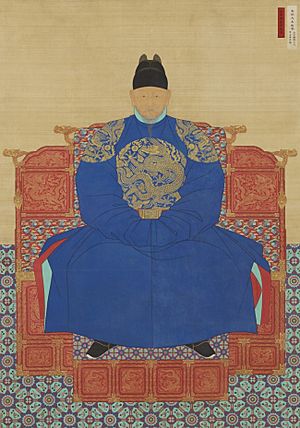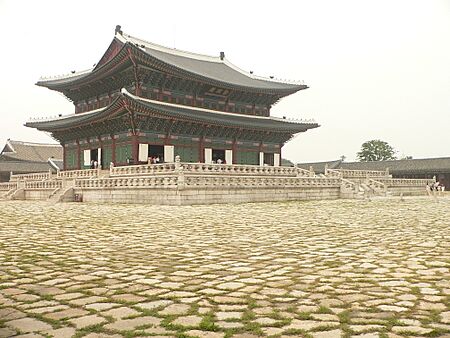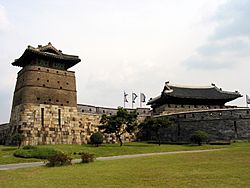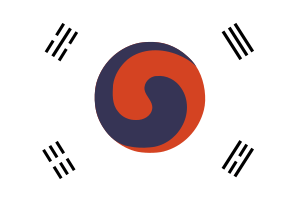History of the Joseon dynasty facts for kids
The Joseon dynasty ruled Korea for a very long time, from 1392 to 1897. Its history is usually split into two main parts: the early period and the late period. The big event that divides these periods is the Imjin War (1592–1598). All the records from the Joseon dynasty are kept in the royal archives at the National Museum of the Annals of the Joseon Dynasty in Pyeongchang, which opened in 2023.
Contents
- How the Joseon Dynasty Began
- Starting the New Joseon Kingdom
- Early Challenges for the New Kings
- King Taejong Strengthens the Nation
- Challenges After Sejong
- Troubles with Scholars and Power Struggles
- Political Factions and Divisions
- Japanese Invasions of Korea (1592–1598)
- Manchu Invasions and Isolation
- Political Factions Continue
- Late Joseon Period: Peace and Problems
- The End of Joseon
- See also
- Images for kids
How the Joseon Dynasty Began
By the late 1300s, the old Goryeo dynasty, which had ruled Korea for 400 years, was falling apart. Years of war and control by the weakening Mongol Empire had made it very weak. People also questioned if the royal family was still fit to rule. There were many fights among powerful nobles, generals, and ministers.
Who Were the Key Leaders?
Two important generals stood out because they fought off foreign threats: Yi Seong-gye and Ch'oe Yŏng. There were also two main groups of officials: the reform-minded Sinjin scholars and the old aristocratic Gwonmun families.
The Rise of Yi Seong-gye
Goryeo tried to stay neutral between the rising Ming dynasty in China and the old Mongol Yuan dynasty. But in 1388, the Ming dynasty demanded a large part of Goryeo's northern land. General Ch'oe Yŏng wanted to invade the Liaodong Peninsula to get back old Korean territory. General Yi Seong-gye was chosen to lead this invasion, even though he disagreed with it.
At Wihwa Island, Yi Seong-gye decided to turn his army around and march back to the capital, Gaegyeong (modern-day Gaeseong). He overthrew General Ch'oe and took control. He then replaced King U with his son, King Chang, and later killed both King U and King Chang. He put another royal, Yo, on the throne, who became King Gongyang.
Yi Seong-gye worked with the Sinjin scholars. One of his first actions was to take land from the wealthy Gwonmun aristocrats and give it to his supporters. In 1392, Yi Seong-gye's son, Yi Bang-won, had a loyal Goryeo official named Jeong Mong-ju killed. Soon after, Yi Seong-gye removed King Gongyang from power and became king himself. This was the end of the Goryeo dynasty after nearly 500 years.
Starting the New Joseon Kingdom
When Yi Seong-gye became king, he was known as King Taejo. At first, he thought about keeping the name Goryeo for the country. But his officials believed a new name was needed to show the big change. So, in 1393, he named his new kingdom "Great Joseon," hoping to bring back the glory of an even older kingdom called Gojoseon. However, people just called it the Joseon dynasty.
What Happened to the Old Royal Family?
King Taejo and his officials worried that the remaining members of the old Goryeo royal family (the Wang clan) might try to rebel. So, they tricked the Wang family into boarding a ship, telling them they would live quietly on Ganghwa Island. But it was a trap. A crew member sank the ship, and many members of the Wang family drowned. Some who survived changed their family name to hide their true identity.
Choosing a New Capital City
It was a tradition for new dynasties in Korea to move their capital. This was believed to bring good luck according to a philosophy called feng shui. The old capital, Gaegyeong, was thought to have lost its special energy.
Three places were considered for the new capital: Mount Gyeryong, Muak, and Hanyang. Hanyang was chosen because it was easy to reach by land and sea, and it was in the center of the Korean Peninsula. It also had large mountains for defense and a fertile river valley. In 1394, Hanyang was declared the new capital and renamed Hanseong. (Today, it is Seoul, the capital of South Korea.) Construction began, and the main palace, Gyeongbok Palace, was finished in 1395.
Early Challenges for the New Kings
King Taejo had two wives and many sons. His first wife, Queen Sineui, had six sons. His second wife, Queen Sindeok, had two sons. When it was time to choose a successor, King Taejo's fifth son, Yi Bang-won, had helped his father the most. However, Yi Bang-won strongly disliked Prime Minister Jeong Do-jeon, who was a close ally of King Taejo.
The First Fight Among Princes
Jeong Do-jeon convinced King Taejo to choose his youngest son, Yi Bang-seok (son of Queen Sindeok), as the next ruler. After Queen Sindeok died, Jeong Do-jeon planned to kill Yi Bang-won and his brothers. In 1398, Yi Bang-won found out about this plan. He attacked the palace, killing Jeong Do-jeon, his followers, and Queen Sindeok's two sons. This event is known as the First Strife of Princes.
King Taejo was shocked and sad. He immediately made his second son, Yi Bang-gwa (who became King Jeongjong), the new ruler. Then, King Taejo left the capital.
The Second Fight Among Princes
King Jeongjong moved the capital back to Kaesong. Yi Bang-won still wanted to be the next king. But his older brother, Yi Bang-gan, also wanted power. In 1400, their rivalry led to another conflict, called the Second Strife of Princes. Yi Bang-won won, and Yi Bang-gan was sent away. King Jeongjong was scared and quickly made Yi Bang-won his successor. Soon after, King Jeongjong gave up the throne, and Yi Bang-won became King Taejong.
In 1401, the Joseon Dynasty officially became a friendly, but smaller, state to the powerful Ming dynasty of China.
King Taejong Strengthens the Nation
King Taejong's father, King Taejo, was still angry and refused to give him the royal seal, which showed that Taejong was the rightful king. Taejong sent many messengers to get the seal, but King Taejo killed them all. This event is called the Case of the Hamhung Envoys.
Building a Stronger Government
To prove his right to rule, King Taejong made many important changes.
- He stopped powerful government officials and nobles from having their own private armies. This made the national army much stronger.
- He revised tax laws for land ownership. Many rich people had hidden their land to avoid paying taxes. King Taejong found this hidden land, which doubled the country's income.
- In 1413, he ordered the first population survey. All Korean men over 16 had to carry wooden tablets with their name and birth date. This helped prevent men from avoiding military service.
King Taejong also changed how the government worked. He got rid of the old Dopyeong Assembly, which had too much power. He created the State Council of Joseon, which worked closely with the king. He also made a rule that all government decisions needed the king's approval. This greatly increased the king's power. He also created the Sinmun Office where people could report if they were treated unfairly by officials.
King Sejong the Great
In 1418, King Taejong gave up the throne, and his son Sejong became king. King Taejong still helped with military matters until he died in 1422.
King Sejong was a great military leader. In 1419, he launched an expedition against Japanese pirates who were attacking Korea from Tsushima Island. The pirates surrendered, and in 1443, a treaty was signed allowing them to trade with Korea in exchange for stopping pirate raids.
On the northern border, King Sejong built forts and posts to protect his people from the Jurchens (who later became the Manchus). In 1433, he sent General Kim Jong-seo to fight the Jurchens. Kim's campaign pushed them back and restored Korean territory, which is roughly the border between North Korea and China today.
King Sejong's rule was a golden age for Korea. There were big advances in science, farming, literature, and medicine. He is known as "King Sejong the Great." His most famous achievement was creating Hangul, the Korean alphabet, in 1443. Before this, Koreans used Chinese characters (Hanja) for writing. Hangul made it much easier for everyone to read and write.
Challenges After Sejong
After King Sejong died, his son Munjong became king but died two years later in 1452. Munjong's young son, Danjong, became king at age 12.
The Six Martyred Ministers
Danjong's uncle, Sejo, took the throne from him in 1455. Six loyal ministers tried to kill Sejo to put Danjong back on the throne. Sejo had these six ministers executed and also killed Danjong, who was in exile. Even though he took the throne by force, King Sejo was a capable ruler. He improved the government system, the economy, and encouraged the printing of books. He also created the Grand Code for State Administration, which was the first written law for the country.
Sejo's son Yejong became the eighth king but died two years later. Yejong's nephew Seongjong then became king. His reign was a time of growth and prosperity. He encouraged scholars who followed Neo-Confucian ideas, called Sarim, to join the government. He created a royal library and advisory council called Hongmungwan, where scholars discussed philosophy and government policies. He also launched military campaigns against the Jurchens to secure the northern border.
Troubles with Scholars and Power Struggles
The Tyrant King Yeonsangun
King Seongjong's son, Yeonsangun, is often seen as the worst ruler of the Joseon Dynasty. His reign was marked by bloody purges of Neo-Confucian scholars between 1498 and 1506. His behavior became wild after he learned that his birth mother, Consort Yoon, had been forced to drink poison. He punished those who had accused her and killed scholars who had criticized his uncle Sejo for taking the throne. He also used the Royal University as his personal playground and banned the use of Hangul after commoners used it to criticize him. After 12 years, he was removed from power in a coup, and his half-brother Jungjong became king in 1506.
King Jungjong and His Reforms
King Jungjong was a weak king because he came to power through a coup. However, his minister Jo Gwang-jo, a leader of the Sarim scholars, brought in many important reforms. He tried to create a local self-government system, reduce the gap between rich and poor, and spread Confucian writings. He was very strict about applying the law. These reforms were popular with common people but were strongly opposed by conservative officials. They tricked King Jungjong into doubting Jo's loyalty. Jo Gwang-jo was executed, and most of his reforms ended with him in 1519. For the next 50 years, court politics were filled with chaotic struggles between different groups supporting rival royal family members.
Political Factions and Divisions
The Sarim scholars, who had suffered under previous kings, gained control of the government under King Seonjo. But they soon split into different groups: the Western faction and the Eastern faction. The Eastern faction then split into Northern and Southern factions. These groups often fought for power, and changes in power often led to accusations of treason and bloody purges.
For example, in 1589, a leader of the Eastern faction, Jeong Yeo-rip, was accused of planning a rebellion. The head of the Western faction used this case to remove many Easterners from power, killing or exiling a thousand of them.
Japanese Invasions of Korea (1592–1598)
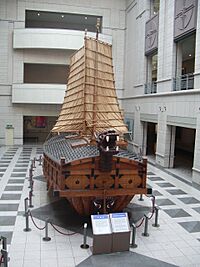
Japanese pirates had attacked Korea many times before. The Korean navy used advanced gunpowder weapons like cannons and fire arrows to fight them off.
In 1592 and 1597, the Japanese warlord Toyotomi Hideyoshi invaded Korea, hoping to conquer China. The Joseon court was divided and unprepared. The Japanese, using European firearms, quickly took over much of the southern part of Korea, capturing Pyongyang and Hanseong (Seoul). Some Korean slaves even joined the Japanese and burned down the palace and slave records.
How Korea Fought Back
However, local resistance groups slowed the Japanese advance. Admiral Yi Sun-sin won important naval battles, controlling the sea routes and cutting off Japanese supplies. Ming China also sent a large army to help Korea in 1593. During the war, Koreans developed powerful firearms and the famous Turtle ships.
The Joseon and Ming forces defeated the Japanese, who retreated in 1598 after Hideyoshi died. Admiral Yi Sun-sin was killed in the Battle of Noryang while pursuing the retreating Japanese.
The war had a terrible cost. Farmlands were ruined, villages were burned, and many skilled workers were killed or taken to Japan. The Japanese also stole many Korean historical books and treasures. After the war, relations between Korea and Japan stopped for a while. Later, Japan's new ruler, Tokugawa Ieyasu, wanted to trade with Korea again. In 1604, he released about 3,000 Korean captives. In 1607, diplomatic and trade relations were slowly restored.
Manchu Invasions and Isolation
After the Japanese invasions, Korea became more isolated from other countries. The Ming dynasty in China was weakened, and a new Qing dynasty (Manchus) rose to power. Korea decided to strengthen its borders and limit travel.
Korea was invaded twice by the Manchus, in 1627 and 1637. Korea eventually surrendered and became a tributary state of the Qing dynasty, meaning they had to send tribute missions to China.
Political Factions Continue
Throughout the Joseon era, different political groups fought for power. These groups often formed around regional differences or ideas. For example, the Eastern and Western factions, and later the Northern and Southern factions, constantly struggled for control. These fights were often about who should be the next king or how the king should behave.
In the 18th century, King Yeongjo and King Jeongjo tried to create a policy of equality, not favoring any one group. However, new conflicts arose. By the 19th century, powerful families connected to the royal family through marriage gained control, rather than scholarly factions.
Late Joseon Period: Peace and Problems
After the Manchu invasions, Joseon had almost 200 years of peace. King Yeongjo and King Jeongjo led a new period of growth and development. They tried to fix the problems caused by political factions.
King Jeongjo made many reforms. He created Kyujanggak, a royal library, to improve culture and politics. He also opened government jobs to people who were previously excluded because of their social status. He was supported by scholars who believed in practical learning, called Silhak. King Jeongjo's reign also saw the growth of popular culture.
Famines and Rebellions
In the 19th century, Korea suffered from droughts and floods, leading to terrible famines. Rulers increased taxes on farmers and demanded more free labor from them. This caused anger and led to violent uprisings.
In 1812, Hong Gyeong-nae led a peasant rebellion in northern Korea. In 1862, farmers in Jinju also rebelled against corrupt officials and rich landowners. The whole country was in chaos. Choe Je-u started a new movement called Donghak (Eastern Learning) in the 1860s. This movement involved peasants forming anti-government groups that took over parts of southern Korea.
Opening to the West
In 1863, King Gojong became king. His father, Regent Heungseon Daewongun, ruled for him. Daewongun was known for his policy of isolationism, meaning he wanted to keep Korea closed off from other countries. He also severely punished Christians. This policy led to conflicts with Western powers.
- In 1866, France attacked Korea (known as Byeonginyangyo) because French priests were executed. The French eventually retreated, which made Korea even more determined to stay isolated.
- In 1871, the United States sent an expedition to Korea (known as Sinmiyangyo) to try to establish trade and find out what happened to an American merchant ship. This also led to fighting, and the Americans failed to achieve their goals.
In 1875, a small Japanese warship, the Un'yō, attacked a Korean port without permission. Japan then demanded a treaty. The Treaty of Ganghwa in 1876 was the first "unequal treaty" for Korea. It gave Japanese citizens special rights in Korea, forced Korea to open three ports for trade, and made Korea declare its independence from China in foreign relations.
The End of Joseon
In the 19th century, tensions grew between China and Japan, leading to the First Sino-Japanese War (1894–1895), which was largely fought in Korea. Japan, with its modern military, began to take control of Korea's resources and economy.
Rebellions and Coups
As the dynasty weakened, the king started to rely on new, rifle-using armies. The old army, who used spears and old guns, were paid less and revolted in response.
In 1884, a small group of revolutionaries tried to stage a coup, but it failed quickly.
The Donghak Peasant Revolution
The Donghak Peasant Revolution was a large movement against the government, the wealthy elite, and foreign influence. Peasants demanded land redistribution, lower taxes, and more rights. Taxes were so high that many farmers had to sell their land.
In January 1894, peasant leader Jeon Bong-jun defeated government forces. The government and the peasant army made an agreement. However, the Joseon government then asked China for help to end the revolt. China sent troops, which led to Japan also sending troops, starting the First Sino-Japanese War.
In late 1894, the peasant army was defeated by Japanese and pro-Japanese government troops in the Battle of Ugeumchi. The Japanese had modern weapons, while the peasants only had old weapons. Jeon Bong-jun was captured and executed. Although the revolution failed, many of the peasants' demands were later addressed through reforms.
Assassination of Empress Myeongseong
In 1895, Empress Myeongseong (also known as "Queen Min") was assassinated by Japanese agents. She had tried to stop Japanese interference in Korea and was looking for support from Russia or China. The Japanese minister to Korea planned the attack. Japanese agents entered the royal palace and killed the empress.
The Korean Empire
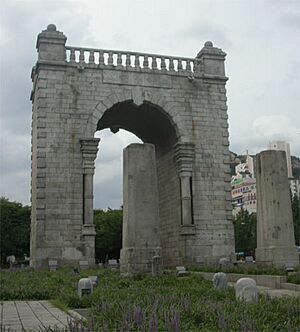
China's defeat in the 1894 war meant Korea was officially independent from China. This was a step for Japan to gain more control over Korea. After this, Korea built the Independence Gate and stopped paying tribute to China.
Feeling pressure from powerful countries, the Joseon court declared the Korean Empire in 1897 to show its independence. King Gojong took the title of emperor. He tried to make reforms, but faced opposition from his people and from Japan.
Technically, 1897 marks the end of the Joseon period because the country's name changed. However, the same royal family continued to rule, but with increasing Japanese interference.
Japanese Occupation
After the Russo-Japanese War (1904–1905), Japan gained control over Korea. In 1905, Korea became a protectorate of Japan, meaning Japan controlled its foreign affairs. Itō Hirobumi became the first Japanese resident general of Korea. He was assassinated by a Korean independence activist, An Jung-geun, in 1909.
King Gojong sent representatives to a peace conference in 1907 to try to get Korea's independence back, but they were blocked by Japanese delegates. Japan then forced Gojong to give up his throne, and his son Sunjong became king.
Finally, in 1910, the Japanese Empire forcefully annexed Korea, ending the Joseon dynasty's rule.
See also
Images for kids


